Bichop R.H. (Ed.) Mechatronic Systems, Sensors, and Actuators: Fundamentals and Modeling
Подождите немного. Документ загружается.

20-84 Mechatronic Systems, Sensors, and Actuators
series for average temperature, while the current devices are connected in series for minimum and parallel
for average. In addition to such simple applications of constant current or voltage sources based upon
temperature, there are a wide variety of novel circuits to derive almost any function imaginable as a basis
of temperature measurement.
Although there is a very small area on the silicon chip of the IC, which is temperature sensitive, it is
convenient to regard the entire chip, its case, and the bonded lead wires as the sensor. This increase in
thermal mass lowers the time response of the device to several seconds. Self-heating and heat transfer
through the leads are also of concern and limit the applicability of these devices in critical measurements.
20.6.5 Noncontact Thermometers
All of the previously discussed temperature monitoring systems implied that the sensor of whatever type
is in physical contact with the object being monitored, or in some special cases is the actual object being
measured. Often times it is impractical to make this physical connection and noncontact modes of
temperature measurement have been developed to overcome this objection. Almost all of these techniques
require that the infrared emissions from the surface of the object be measured, but in a few special cases
other surface optical properties such as reflectance can be exploited to determine the temperature
remotely.
20.6.5.1 IR Emission Thermometers
Any object above absolute zero emits electromagnetic radiation whose spectrum is related to its surface
temperature and surface emissivity. By characterizing the spectrum, the temperature of the object can be
determined directly and absolutely. The microwave background of the universe at 3 K, and the temperature-
dependent color of stars are extreme examples of this phenomena. Temperature can still be determined
from the emitted surface without using a spectrometer. If two bodies are allowed to come into thermal
equilibrium with each other and the temperature of one body is known, the temperature of the other is
also known. This is the basis of all previously discussed temperature-measuring devices assuming conduc-
tion as the principle means of heat transfer. This can be extended to noncontact thermometers since
radiation heat transfer is also a valid means of two bodies coming into thermal equilibrium. Many IR
thermometers are based upon this phenomenon.
In its simplest form, an IR thermometer would consist of a temperature sensor for monitoring the
temperature of an isolated object called the detector, and this detector would only be subject to radiative
heat transfer with the surface whose temperature is to be measured. This would work assuming that both
the surface and detector behave as black bodies, that there is no heat loss from the detector to the
surroundings, and that the field of view of the detector is restricted to the object under measurement
and otherwise totally unobstructed. Each one of these assumptions has to be considered when going
from the ideal case to a real IR thermometer.
The concept of a black body is an idealization where all radiant energy is completely absorbed by the
surface. Under this assumption, the radiant energy is a function only of the temperature of the surface.
The only alternatives to being absorbed by the surface are to be reflected by the surface or transmitted
through the material. The emissivity, which describes the deviation of a real surface from a black body,
is then just one minus its reflectance minus its transmittance. If the emissivity is less than one but
independent of wavelength, then it is a gray body. Few real materials are either black bodies or gray
bodies, thus emissivity corrections must be made which will often be a function of the temperature being
measured. If the surface behaves like a gray body over a limited range of wavelengths, the intensity at a
few wavelengths in this range can be measured to estimate the entire spectral shape. It is fortunate that
many real objects are close to gray over a narrow range of wavelengths around 750 nm and the spectral
shape as a function of temperature for gray objects in the temperature range of 500–3000°C is well
enough behaved at these wavelengths that the spectral shape, and thus the temperature, can be measured
with just two points. The emissivity of a surface can be determined in conjunction with taking its
9258_C020_Sec_4-6.fm Page 84 Tuesday, October 9, 2007 9:09 PM
Sensors 20-85
temperature by illuminating the surface with an IR laser and measuring the amount of the known laser
light that is reflected. The total IR during illumination is the sum of the reflected laser light and the
thermally emitted IR. If care is taken that only short pulses or low power laser light is used, to avoid
heating the measured surface, this will yield the reflectance at the wavelength of the laser and thus its
emissivity which, for opaque surfaces, is one minus reflectance.
Heat transfer to and from the detector by means other than thermal radiation exchange with the
monitored surface will require that the temperature of the detector be regarded as only representing the
temperature of the monitored surface rather than being the same as the monitored surface. Heat transfer
from the detector to the instrument can be via conduction or radiation and is accommodated by calibrating
the instrument against a black body of known temperature. When this is done, the temperature of the
instrument is usually monitored and circuitry may be set up to have the reference junction for the detector
monitor the instrument casing temperature. Alternatively the actual photon flux can be measured by
electronic means using photodiodes, photoresistive cells, or other such electronic photon sensors sensitive
to IR. When this is done, narrow band filters are often used to limit the response of the detector to a
particular wavelength of IR radiation to avoid counting visible photons that may be reflected from the
surface or to limit the response to a particular wavelength where atmospheric interferences are minimized.
Optical components are often employed to limit the field of view of the detector so that a defined
portion of the surface to be measured is brought to focus on the detector. As long as the entire detector
sees the surface of interest, the distance between the detector and the surface is not important, except as
it relates to IR absorption by the H
2
O, CO
2
, or other IR active gasses in the air.
A variation of the IR techniques discussed above is the disappearing filament pyrometer. This device
superimposes the image of a tungsten filament whose temperature is a known function of current through
the filament onto the view through a telescope. The walls of a furnace or other incandescent surface are
observed through the telescope while adjusting the filament current until it just disappears in the
background glow. The temperature of the filament then matches the temperature of the incandescent
surface and can be determined from the current through the filament. A simple refinement is to put a
narrow band red filter in the telescope so that the color is the same for both the target and the filament,
and it becomes a single wavelength brightness comparison rather than radiation color comparison. If
the emissivity of both the filament and the surface is unity, this can be very accurate. If not equal to one,
when a monochromatic filter is used, only the emissivity at that one wavelength needs to be known for
accurate temperature determinations.
20.6.6 Microscale Temperature Measurements
As the microelectronics industry surges forward with increasingly higher operating frequencies and
increasingly smaller device dimensions, measurement techniques with high spatial and/or temporal res-
olution are becoming increasingly important. Few techniques are available that can actually measure
temperature on a microscale, that is, sub-micron spatial resolution and/or sub-microsecond temporal
resolution. However, many techniques that are being developed concentrate on observing the differential
temperature on a microscale. The transient thermoreflectance technique, for example, utilizes a femtosec-
ond pulsed laser to heat and probe the transient reflectance of the sample to enable observation of thermal
transport on a sub-picosecond time scale. The technique involves relating the measured reflectivity changes
to temperature changes using the material’s complex index of refraction (Rosei and Lynch, 1972).
The three most common methods of observing microscale thermal phenomena include thin film
thermocouples, thin film microbridges, and optical techniques. Nanometer scale thermocouples are typ-
ically used in conjunction with an atomic force microscope (AFM). This technique is nondestructive since
the AFM brings the probe into contact with the sample very carefully. Thin film microbridges are patterned
metallic thin films, usually thinner than 100 nanometers with a width that depends on the application.
This technique relies on the fact that the electrical resistance of the microbridge is a strong function of
temperature. The microbridge must be deposited onto the sample surface, therefore the technique is
neither noncontact nor nondestructive. Optical techniques typically use a laser as the heating source
9258_C020_Sec_4-6.fm Page 85 Tuesday, October 9, 2007 9:09 PM
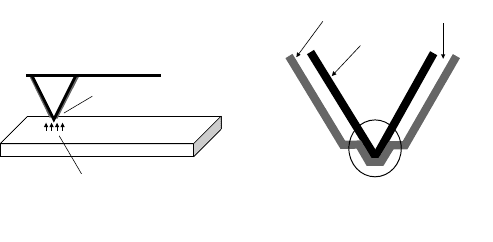
20-86 Mechatronic Systems, Sensors, and Actuators
and/or the thermal probe. The thermal effects can be observed optically in a number of different ways.
Thermoreflectance techniques rely on the temperature dependence of reflectance (Paddock and Eesley,
1986), while photothermal techniques monitor the deflection of the probe beam by thermal expansion
that results at the surface (Welsh and Ristau, 1995). “Mirage” techniques use the fact that the air just
above the surface is also heated, which causes changes in the index of refraction that bends the probe
beam by varying amounts depending on the change in temperature (Gonzales et al., 2000).
20.6.6.1 Scanning Thermal Microscopy
The scanning thermal microscopy (SThM) is perhaps the best example of an actual temperature measurement
on sub-micron length scales. The nanometer scale thermocouple is comprised of thin metallic films deposited
directly onto commercially available AFM probes. Majumdar published a comprehensive review of SThM
and includes a description of several methods for manufacturing these nanometer thermocouples (Majum-
dar, 1999). Figure 20.59a shows a diagram of a scanning thermal microscope probe and Figure 20.59b is a
schematic of a typical thermocouple junction. There are several factors that affect the spatial resolution of
the measurement. These factors include the tip size of the thermocouple which can be on the order of 20
and 50 nm, the mean free path of the energy carrier of the material to be characterized, and the mechanism
of heat transfer between the sample and the thermocouple, which is ultimately the limiting factor.
Operation of the AFM cantilever is identical to that of a standard AFM probe. Ideally, the thermocouple
would quickly come to thermal equilibrium once in contact with the sample without affecting the tem-
perature of the surface. Practically, a certain amount of thermal energy is transferred between the sample
and the thermocouple, which affects the sample temperature, and there is also thermal resistance which
delays the measurement and limits the spatial resolution. Once the sample and the thermocouple are
brought into contact, there is solid–solid thermal conduction from the sample to the thermocouple. There
is also thermal conduction through the gas surrounding the thermocouple tip and through a liquid layer
that condenses in the small gap between the tip and the sample. Shi et al. (2000) demonstrated that
conduction through this liquid layer dominates the heat transfer under normal atmospheric conditions.
20.6.6.2 Transient Thermoreflectance Technique
The transient thermoreflectance (TTR), while not capable of monitoring temperature directly, is an optical
technique that enables measurement of temperature changes with sub-picosecond temporal resolution. This
technique
is fully noncontact and relies on the fact that reflectivity is a function of temperature. The TTR
experimental
setup (Paddock and Eesley, 1986; Elsayed-Ali et al., 1991; Hostetler et al., 1997) shown in
Figure 20.60 can be employed to monitor the thermoreflectance response of a metallic sample after the
absorption o
f an ultra-short laser pulse. The pulses from a femtosecond laser operating at 76 MHz are separated
into two beams, an intense “pump” beam, which is used to heat the film, and a low power “probe” beam,
which is used to monitor the reflectivity. The pump beam passes through an acousto-optic modulator that
FIGURE 20.59 (a) Diagram showing the use of a scanning thermal microscope probe. (b) Schematic of a nanometer
scale thermocouple maufactured onto the tip of a commercially available AFM cantilever.
AFM probe
Nanometer scale thermocouple
fabricated onto the tip
Heat transfer to thermocouple
from the sample surface
Sample
Metal 2
Metal 1
Insulating layer
Thermocouple junction
(a) (b)
9258_C020_Sec_4-6.fm Page 86 Tuesday, October 9, 2007 9:09 PM
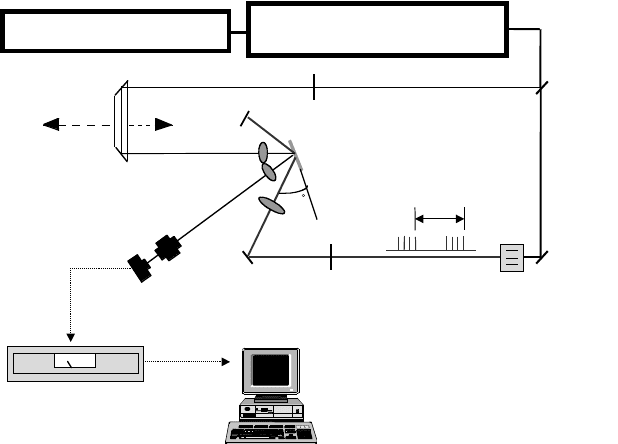
Sensors 20-87
effectively
chops the beam on and off at a frequency of 1 MHz, resulting in thermomodulation. The probe
beam passes through a dovetail prism mounted on a movable stage, which is used to increase the optical
path length of the probe beam and hence the time delay between the pump and probe pulses. The reflection of
the probe beam, which is centered in the heated area, is monitored by a photodiode and sent to a lock-in amplifier
set to the thermomodulation frequency of 1 MHz. This yields the temporal relaxation profile of the sample.
Employing the TTR method as a temperature probe involves relating the measured reflectivity changes
to temperature changes using the material’s complex index of refraction. In most metals and dielectrics,
the complex index of refraction depends weakly on temperature (Price, 1947). In wavelength ranges
where the reflection coefficient is large, the reflectivity can be described by the linear sum of a large static
contribution and a small temperature-dependent modulated contribution. The corresponding change in
reflectivity is ∼10
−5
/K. The lock-in detection at 1 MHz enables resolution of the small transient signal.
By comparing the transient thermal response of a surface to the appropriate heat conduction model,
thermophysical properties such as the thermal diffusivity and the thermal boundary resistance can be
measured (Hostetler et al., 1997; Hostetler et al., 1998; Smith et al., 2000).
20.6.7 Closing Comments
A wide variety of sensors are available for monitoring the parameter we refer to as temperature. The choice
of the appropriate sensor is highly dependent upon the actual physical configuration of the measured
material, as well as the required precision, accuracy, and display or processing of the temperature. While
thermocouples may be an excellent choice for situations involving electrical logging of a remote process,
a gas-bulb thermometer may be adequate and more appropriate for monitoring remote temperatures
divorced from electricity. The physical geometry, which often limits access to the area of interest, is another
important consideration. It is also important to consider the accuracy requirement, as well as the spatial
and temporal resolution desired. This discussion is meant to provide a cursory overview of a wide array
of temperature-sensing techniques. There are many excellent, comprehensive references and the designer
is referred to these for more details. Temperature measurement often resembles an art rather than a
science, with new and creative techniques for monitoring thermal responses in continuous development.
FIGURE 20.60 Experimental setup of the transient thermoreflectance technique.
Probe beam 5%
Pump
beam 95%
Sample
Dove prism
Delay 1500ps
Acousto-Optic
modulator @1 MHz
Lens
λ
/
2
Plate
Ti:Saph laser 76 MHz
τ
p
= 200 fs
1 s
µ
Polarizer
Detector
Beam splitter
20:1
60
Lock-in amplifier 1 MHz
Variable
ND filter
Solid state diode pumped laser
= 532 nm ~9W
λ
= 720 nmÐ880 nm (1.4 eV - 1.7 eV)
λ
9258_C020_Sec_4-6.fm Page 87 Tuesday, October 9, 2007 9:09 PM

20-88 Mechatronic Systems, Sensors, and Actuators
As nanotechnology progresses, many more advances in the area of sub-micron/sub-microsecond temper-
ature measurements will become vital, since many of the traditional means of measuring temperature are
not easily adapted to small local temperature measurements.
References
Analog Devices Data Sheet for AD590 Temperature Transducer, 1997.
Croarkin, M.C., et al., 1993, “Temperature-electromotive force reference functions and tables for the
letter-designated thermocouple types based on the ITS-90,” National Institute of Standards and
Technology, Monograph 175.
Doebelin, E.O., Measurement Systems, Application and Design, McGraw-Hill, New York, 1990.
Elsayed-Ali, H.E., Juhasz, T., Smith, G.O., and Bron, W.E., 1991, “Femtosecond thermoreflectivity and
thermotransmissivity of polycrystalline and single-crystalline gold films,” Phys. Rev. B, Vol. 43,
pp. 4488–4491.
Gonzales, E.J., Bonevich, J.E., Stafford, G.R., White, G., and Josell, D., 2000, “Thermal transport through
thin films: mirage technique measurements on aluminum/titanium multilayers,” J. Mater. Res.,
Vol. 15, pp. 764–771.
Hostetler, J.L., Smith, A.N., and Norris, P.M., 1997, “Thin-film thermal conductivity and thickness mea-
surements using picosecond ultrasonics,” Micro. Thermophys. Eng., Vol. 1, pp. 237–244.
Hostetler, J.L., Smith, A.N., and Norris, P.M., 1998, “Simultaneous measurement of thermophysical and
mechanical properties of thin films,” Int. J. Thermophys., Vol. 19, pp. 569–577.
Majumdar, A., 1999, “Scanning thermal microscopy,” Ann. Rev. Mater. Sci., Vol. 29, pp. 505–585.
Mangum, B.W. and Furukawa, G.T., 1990, “Guidelines for realizing the international temperature scale
of 1990 (ITS-90),” National Institute of Science and Technology, Technical Note 1265.
National Semiconductor Data Sheet for LM135 series Temperature Sensors, DS005698, 2000.
Paddock, C.A. and Eesley, G.L., 1986, “Transient thermoreflectance from thin metal films,” J. Appl. Phys.,
Vol. 60, pp. 285–290.
Price, D.J., 1947, “The temperature variation of the emissivity of metals in the near infrared,” Proc. Phys.
Soc. (London), Vol. 59, pp. 131.
Rosei, R. and Lynch, D.W., 1972, “Thermomodulation spectra of Al, Au, and Cu,” Phys. Rev. B, Vol. 10,
pp. 474–483.
Shi, L., Plyasunov, S., Bachtold, A., McEuen, P.L., and Majumdar, A., 2000, “Scanning thermal microscopy
of carbon nanotubes using batch-fabricated probes,” Appl. Phys. Lett., Vol. 77, pp. 4295–4297.
Smith, A.N., Hostetler, J.L., and Norris, P.M., 2000, “Thermal boundary resistance measurements using
a transient thermoreflectance technique.” Micro. Thermophys. Eng., Vol. 4, No. 1, pp. 51–60.
Welsh, E. and Ristau, D., 1995, “Photothermal measurements on optical thin films,” Appl. Opt., Vol. 34,
pp. 7239–7253.
20.7 Distance Measuring and Proximity Sensors*
Jorge Fernando Figueroa and H. R. (Bart) Everett
20.7.1 Distance Measuring Sensors
20.7.1.1 Introduction
Range sensors are used to measure the distance from a reference point to an object. A number of
technologies have been applied to develop these sensors, the most prominent being light/optics, computer
vision, microwave, and ultrasonic. Range sensors may be of contact or noncontact types.
*Significant portions of this chapter were condensed from “Sensors for Mobile Robots”, by H. R. Everett, with
permission from A. K. Peters, Ltd., Natick, MA.
9258_C020_Sec_4-6.fm Page 88 Tuesday, October 9, 2007 9:09 PM
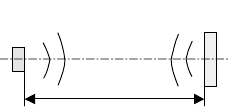
Sensors 20-89
20.7.1.2 Noncontact Ranging Sensors
Sensors that measure the actual distance to a target of interest with no direct physical contact are referred
to as noncontact ranging sensors. There are at least seven different types of ranging techniques employed
in various implementations of such distance measuring devices (Everett et al., 1992):
•
Tr ia ng ul ation
•
Time of flight (pulsed)
•
Phase-shift measurement (CW)
•
Frequency modulation (CW)
•
Interferometry
•
Swept focus
•
Return signal intensity
Noncontact ranging sensors can be broadly classified as either active (radiating some form of energy into
the field of regard) or passive (relying on energy emitted by the various objects in the scene under
surveillance). The commonly used terms radar (radio direction and ranging), sonar (sound navigation
and ranging), and lidar (light direction and ranging) refer to active methodologies that can be based on
any of several of the above ranging techniques. For example, radar is usually implemented using time-
of-flight, phase-shift measurement, or frequency modulation. Sonar typically is based on time-of-flight
ranging, since the speed of sound is slow enough to be easily measured with fairly inexpensive electronics.
Lidar generally refers to laser-based schemes using time-of-flight or phase-shift measurement.
For any such active (reflective) sensors, effective detection range is dependent not only on emitted
power levels, but also the following target characteristics:
•
Cross-sectional area—determines how much of the emitted energy strikes the target.
•
Reflectivity—determines how much of the incident energy is reflected versus absorbed or passed
through.
•
Directivity—determines how the reflected energy is redistributed (i.e., scattered versus focused).
Many noncontact sensors operate based on the physics of wave propagation. A wave is emitted at a reference
point, and the range is determined by measuring either the propagation time from reference to target, or
the decrease of intensity as the wave travels to the target and returns to the reference. Propagation time is
measured using time-of-flight or frequency modulation methods.
Ranging by Time-of-Flight
Time-of-flight (TOF) is illustrated in Figures 20.61 and 20.62. A gated wave (a burst of a few cycles)
is emitted, bounced back from the target, and detected at the receiver located near the emitter. The
emitter and receiver may physically be both one sensor. The receiver may also be mounted on the
target. The TOF is the time elapsed from the beginning of the burst to the beginning of the return signal.
The distance is defined as
d
=
c
⋅
TOF/2 when emitter and receiver are at the same location, or
d
=
c
⋅
TOF
when the receiver is attached to the target. The accuracy is usually 1/4 of the wavelength when detecting
the return signal, as its magnitude reaches a threshold limit. Gain is automatically increased with distance
to maintain accuracy. Accuracy may be improved by detecting the maximum amplitude, as shown in
Figure 20.63. This makes detecting the time of arrival of the wave less dependent on the amplitude
of the signal. Ultrasonic, RF, or optical energy sources are typically employed; the relevant parameters
FIGURE 20.61 A wave is emitted and bounced from a
target object. The distance d is determined from the
speed of travel of the wave, c, and the time-of-flight, TOF
as d = (1/2) · c · TOF.
Emitter/Receiver
Target
d
9258_C020_Sect_7-9.fm Page 89 Tuesday, October 9, 2007 9:09 PM
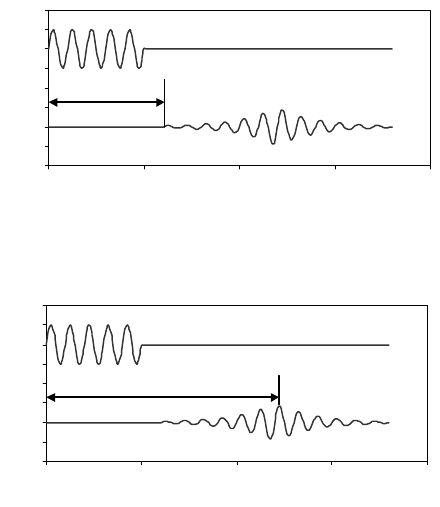
20-90 Mechatronic Systems, Sensors, and Actuators
involved in range calculation, therefore, are the speed of sound in air (roughly 0.305 m/ms), and the
speed of light (0.305 m/ns).
Potential error sources for TOF systems include the following:
•
Variations in the speed of propagation, particularly in the case of acoustical systems
•
Uncertainties in determining the exact time of arrival of the reflected pulse (Figueroa & Lamancusa,
1992)
•
Inaccuracies in the timing circuitry used to measure the round-trip time of flight
•
Interaction of the incident wave with the target surface
Propagation Speed—For most applications, changes in the propagation speed of electromagnetic energy
are for the most part inconsequential and can basically be ignored, with the exception of satellite-based
position-location systems. This is not the case, however, for acoustically based systems, where the speed of
sound is markedly influenced by temperature changes, and to a lesser extent by humidity. (The speed
of sound is actually proportional to the square root of temperature in degrees Rankine; an ambient
temperature shift of just 30° can cause a 1-ft error at a measured distance of 35 ft.)
Detection Uncertainties—So-called time-walk errors are caused by the wide dynamic range in returned
signal strength as a result of (1) varying reflectivity of target surfaces, and (2) signal attenuation to the
fourth power of distance due to spherical divergence. These differences in returned signal intensity
influence the rise time of the detected pulse, and in the case of fixed-threshold detection will cause the
less reflective targets to appear further away (Lang et al., 1989). For this reason, constant fraction timing
discriminators are typically employed to establish the detector threshold at some specified fraction of the
peak value of the received pulse (Vuylsteke et al., 1990; Figueroa & Doussis, 1993).
Timing Considerations—The relatively slow speed of sound in air makes TOF ranging a strong contender
for low-cost acoustically based systems. Conversely, the propagation speed of electromagnetic energy can
place severe requirements on associated control and measurement circuitry in optical or RF implemen-
tations. As a result, TOF sensors based on the speed of light require sub-nanosecond timing circuitry to
FIGURE 20.62 Definition of time-of-flight.
FIGURE 20.63 TOF to the maximum amplitude of the received signal for improved accuracy.
0
1
2
3
4
5
6
7
8
0 5 10 15 20
Amplitude
Emitted signal
Time-of-flight
Return signal
Time
Time-of-Flight to locked-on peak
0
1
2
3
4
5
6
7
8
0 5 10 15 20
Amplitude
Emitted signal
Return signal
Time
9258_C020_Sect_7-9.fm Page 90 Tuesday, October 9, 2007 9:09 PM
Sensors 20-91
measure distances with a resolution of about a foot (Koenigsburg, 1982). More specifically, a desired
resolution of 1 mm requires a timing accuracy of 3 ps (Vuylsteke et al., 1990). This capability is somewhat
expensive to realize and may not be cost effective for certain applications, particularly at close range
where high accuracies are required.
Surface Interaction—When light, sound, or radio waves strike an object, any detected echo represents
only a small portion of the original signal. The remaining energy reflects in scattered directions and can
be absorbed by or pass through the target, depending on surface characteristics and the angle of incidence
of the beam. Instances where no return signal is received at all can occur because of specular reflection
at the object surface, especially in the ultrasonic region of the energy spectrum. If the transmission source
approach angle meets or exceeds a certain critical value, the reflected energy will be deflected outside the
sensing envelope of the receiver. Scattered signals can reflect from secondary objects as well, returning
to the detector at various times to generate false signals that can yield questionable or otherwise noisy
data. To compensate, repetitive measurements are usually averaged to bring the signal-to-noise ratio
within acceptable levels, but at the expense of additional time required to determine a single range value.
Ultrasonic TOF Systems
Ultrasonic TOF ranging is today the most common noncontact technique employed, primarily due to
the ready availability of low-cost systems and their ease of interface. Over the past few decades, much
research has been conducted in investigating applications in mobile robotics for world modeling and
collision avoidance, position estimation, and motion detection. Several researchers have assessed the
effectiveness of ultrasonic sensors in exterior settings (Pletta et al., 1992; Langer & Thorpe, 1992; Pin &
Watanabe, 1993; Hammond, 1994). In the automotive industry, BMW now incorporates four piezocer-
amic transducers (sealed in a membrane for environmental protection) on both front and rear bumpers
in its Park Distance Control system (Siuru, 1994).
The Polaroid ranging module is an active TOF device developed for automatic camera focusing and
determines the range to target by measuring elapsed time between transmission of an ultrasonic waveform
and the detected echo (Biber et al., 1980). Probably the single most significant sensor development is
from the standpoint of its catalytic influence on the robotics research community and industrial appli-
cations; this system is the most widely found in the literature (Koenigsburg, 1982; Moravec & Elfes, 1985;
Everett, 1985; Kim, 1986; Arkin, 1989; Borenstein & Koren, 1990). Representative of the general charac-
teristics of a number of such ranging devices, the Polaroid unit soared in popularity as a direct conse-
quence of its extremely low cost (Polaroid offers both the transducer and ranging module circuit board
for less than $50), made possible by high-volume usage in its original application as a camera auto-focus
sensor.
The most basic configuration consists of two fundamental components: (1) the ultrasonic transducer,
and (2) the ranging module electronics. A choice of transducer types is now available. In the original
instrument-grade electrostatic version (Figure 20.64), a very thin metalized diaphragm mounted on a
machined backplate forms a capacitive transducer (Polaroid, 1981). A smaller diameter electrostatic trans-
ducer (7000-Series) has also been made available, developed for the Polaroid Spectra camera (Polaroid,
1987). A ruggedized piezoelectric (9000-Series) environmental transducer introduced for applications that
may be exposed to rain, heat, cold, salt spray, and vibration is able to meet or exceed guidelines set forth
in the SAE J1455 January 1988 specification for heavy-duty trucks. The range of the Polaroid system runs
from about 0.3 m (1 ft) out to 10.5 m (35 ft), with a half-power (−3 dB) beam dispersion angle of
approximately 12° for the original instrument-grade electrostatic transducer. A typical operating cycle is
as follows.
•
The control circuitry fires the transducer and waits for an indication that transmission has begun.
•
The receiver is blanked for a short period of time to prevent false detection due to residual transmit
signal ringing in the transducer.
•
The received signals are amplified with increased gain over time to compensate for the decrease
in sound intensity with distance.
9258_C020_Sect_7-9.fm Page 91 Tuesday, October 9, 2007 9:09 PM
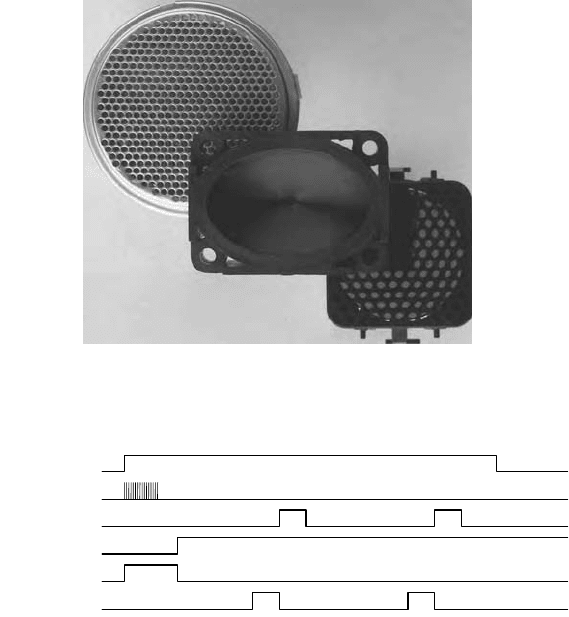
20-92 Mechatronic Systems, Sensors, and Actuators
•
Returning echoes that exceed a fixed-threshold value are recorded and the associated distances
calculated from elapsed time.
In the single-echo mode of operation for the 6500-series module, the blank (BLNK) and blank-inhibit
(BINH) lines are held low as the initiate (INIT) line goes high to trigger the outgoing pulse train. The
internal blanking (BLANKING) signal automatically goes high for 2.38 ms to prevent transducer ringing
from being misinterpreted as a returned echo. Once a valid return is received, the echo (ECHO) output
will latch high until reset by a high-to-low transition on INIT. For multiple-echo processing, the blank
(BLNK) input must be toggled high for at least 0.44 ms after detection of the first return signal to reset
the echo output for the next return, as shown in Figure 20.65 (Polaroid, 1990).
Laser-Based TOF Systems
Laser-based TOF ranging systems, also known as laser radar or lidar, first appeared in work performed
at the Jet Propulsion Laboratory, Pasadena, CA, in the 1970s (Lewis & Johnson, 1977). Laser energy is
emitted in a rapid sequence of short bursts aimed directly at the object being ranged. The TOF of a given
pulse reflecting off the object is used to calculate distance to the target based on the speed of light.
Accuracies for early sensors of this type could approach a few centimeters over the range of 1–5 m (NASA,
1977; Depkovich & Wolfe, 1984).
Schwartz Electro-Optics, Inc. (SEO), Orlando, FL, produces a number of laser TOF rangefinding
systems employing an innovative time-to-amplitude-conversion scheme to overcome the sub-nanosecond
timing requirements necessitated by the speed of light. As the laser fires, a precision film capacitor begins
discharging from a known set point at a constant rate, with the amount of discharge being proportional
FIGURE 20.64 From left to right: (1) the original instrument grade electrostatic transducer, (2) 9000-Series envi-
ronmental transducer, and (3) 7000-Series electrostatic transducer. (Courtesy Polaroid Corp.)
FIGURE 20.65 Timing diagrams for the 6500-Series Sonar Ranging Module executing a multiple-echo-mode cycle
with blanking input. (Courtesy Polaroid Corp.)
Echo
Blanking (INT)
Binh
Transmit (INT)
Blnk
Init
16 Pulses
9258_C020_Sect_7-9.fm Page 92 Tuesday, October 9, 2007 9:09 PM
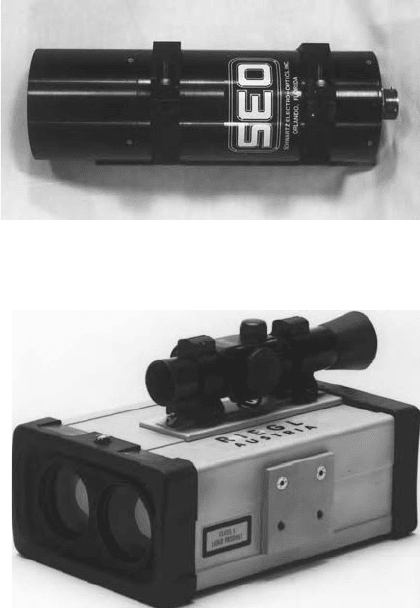
Sensors 20-93
to the round-trip time-of-flight (Gustavson & Davis, 1992). An analog-to-digital conversion is performed
on the sampled capacitor voltage; at the precise instant a return signal is detected, whereupon the resulting
digital representation is converted to range and time-walk corrected using a look-up table.
The LRF-X series rangefinder shown in Figure 20.66 features a compact size, high-speed processing,
and an ability to acquire range information from most surfaces (i.e., minimum 10% Lambertian reflec-
tivity) out to a maximum of 100 m. The basic system uses a pulsed InGaAs laser diode in conjunction
with an avalanche photodiode detector and is available with both analog and digital (RS-232) outputs.
RIEGL Laser Measurement Systems, Horn, Austria, offers a number of commercial products (i.e., laser
binoculars, surveying systems, “speed guns,” level sensors, profile measurement systems, and tracking
laser scanners) employing short-pulse TOF laser ranging. Typical applications include lidar altimeters,
vehicle speed measurement for law enforcement, collision avoidance for cranes and vehicles, and level
sensing in silos.
The RIEGL
LD90-3 series
laser rangefinder (Figure 20.67) employs a near-infrared laser diode source
and a photodiode detector to perform TOF ranging out to 500 m with diffuse surfaces, and to over 1000
m in the case of cooperative targets. Round-trip propagation time is precisely measured by a quartz-
stabilized clock and converted to measured distance by an internal microprocessor, using one of two
available algorithms. The
clutter suppression
algorithm incorporates a combination of range measurement
averaging and noise rejection techniques to filter out backscatter from airborne particulates, and is,
therefore, useful when operating under conditions of poor visibility (Riegel, 1994). The
standard measure-
ment
algorithm, on the other hand, provides rapid range measurements without regard for noise suppres-
sion, and can subsequently deliver a higher update rate under more favorable environmental conditions.
FIGURE 20.66 The LRF-200 series rangefinder. (Courtesy Schwartz Electro Optics, Inc.)
FIGURE 20.67 The Class 1 (eye-safe) LD90-3 series TOF laser rangefinder is a self-contained unit available in several
versions with maximum ranges of 150–500 m under average atmospheric conditions. (Courtesy RIEGL USA.)
9258_C020_Sect_7-9.fm Page 93 Tuesday, October 9, 2007 9:09 PM
